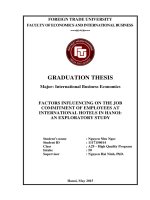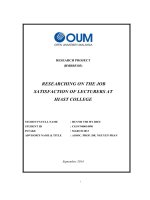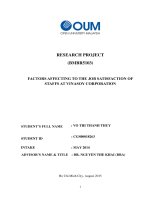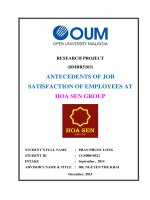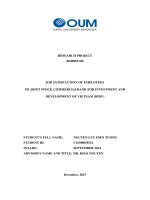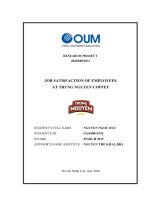Job satisfaction of employees at trung nguyen coffee
Bạn đang xem bản rút gọn của tài liệu. Xem và tải ngay bản đầy đủ của tài liệu tại đây (4.13 MB, 59 trang )
RESEARCH PROJECT
(BMBR5103)
JOB SATISFACTION OF EMPLOYEES
AT TRUNG NGUYEN COFFEE
STUDENT’S FULL NAME
: NGUYEN NGOC DUC
STUDENT’S ID
: CGS00019376
INTAKE
: MARCH 2015
ADVISOR’S NAME AND TITLE : NGUYEN THE KHAI, DBA
Ho Chi Minh City, July 2016
ADVISOR’S ASSESSMENT
....................................................................................................................................
....................................................................................................................................
....................................................................................................................................
....................................................................................................................................
....................................................................................................................................
....................................................................................................................................
....................................................................................................................................
....................................................................................................................................
....................................................................................................................................
....................................................................................................................................
....................................................................................................................................
....................................................................................................................................
....................................................................................................................................
....................................................................................................................................
....................................................................................................................................
Advisor’s signature
ACKNOWLEDMENTS
Firstly and foremost, I would like to express my especial thanks of gratitude to my
advisor, NGUYEN THE KHAI DBA for his elaborate instructions, invaluable
guidance as well as periodical censor during the course within the time of doing this
research project.
Secondly, I’m also thankful to a large number of employees who are working at
Trung Nguyen coffee and a district manager, Mr. Thieu Quang Thanh. All of
them helped me finish the survey and particularly, Mr. Thanh shared his
understanding and experience with me as well as some ideas to solve the current
problem at Trung Nguyen coffee.
Finally, most especially to my wife, who has created the most favorable
environment for me within the course and during the time of completing this
project.
Thank you very much,
HCMC, July 2016
Nguyen Ngoc Duc
CONTENTS
ABTRACT ............................................................................................................................ 1
CHAPTER I: INTRODUCTION .................................................................................... 2
1. About Trung Nguyen group ............................................................................ 2
1.1 History .................................................................................................... 2
1.2 Scope of business .................................................................................... 3
1.3 Development strategy and investment ................................................. 3
1.4 Vision, Missions and Core values. ........................................................ 4
1.5 Contact .................................................................................................... 5
1.6 Organization chart ................................................................................ 5
2. Problem statement............................................................................................ 6
3. Research objectives .......................................................................................... 6
4. Research scope .................................................................................................. 7
5. Significance of the research ............................................................................. 7
6. Limitation of the research ............................................................................... 7
CHAPTER II. LITERATURE REVIEW ...................................................................... 9
1. Definitions of job satisfaction .......................................................................... 9
2. The causes of job satisfaction .......................................................................... 9
3. Theories of job satisfaction ............................................................................ 11
3.1 Maslow’s hierarchy of needs (1943) ................................................... 11
3.2 Herzberg's Hygiene and Motivational Factors (1966) ..................... 13
3.3 McGregor’s Theory X and Theory Y (1957)..................................... 14
3.4 ERG theory of Alderfer (1969) ........................................................... 17
3.5 Equity theory of John Stacey Adams (1963) ..................................... 18
3.6 Theoretical achievements of the McClelland’s (1988)...................... 20
4. Research models ............................................................................................. 21
5. Definition of factors. ....................................................................................... 22
5.1 Overall Job Satisfaction ...................................................................... 22
5.2 Pay Satisfaction Questionnaire........................................................... 22
5.3 Supervisor Support.............................................................................. 23
5.4 Empowerment at Work Scale. ............................................................ 23
5.5 Perceived Importance of Workplace Values. .................................... 23
CHAPTER III: RESEARCH METHODOLOGY .................................................... 25
1. Designing research ......................................................................................... 25
2. Technical analysis of statistical data............................................................. 28
2.1 Testing the reliability of the scales ..................................................... 28
2.2 Linear regression analysis and correlation coefficient ..................... 29
CHAPTER IV: RESULTS .............................................................................................. 30
1. Cronbachs’ Alpha .......................................................................................... 30
2. Calculate the Cronbach’s Alpha .................................................................. 30
2.1 Job Satisfaction (JS) ............................................................................ 30
2.2 Pay Satisfaction (PS) ........................................................................... 31
2.3 Supervisor Support (SS) ..................................................................... 31
2.4 Empowerment at Work (EAT) ........................................................... 31
2.5 Perceived Importance of Workplace Values (PWV) ........................ 32
3. Calculate the descriptive data: Max, Min, Mean, Standard deviation ..... 32
4. Correlations among the variables ................................................................. 32
5. Hypotheses testing result ............................................................................... 33
5.1 Hypothesis proposed (H1) ................................................................... 34
5.2 Hypothesis proposed (H2) ................................................................... 35
5.3 Hypothesis proposed (H3) ................................................................... 36
5.4 Hypothesis proposed (H4) ................................................................... 37
CHAPTER IV: CONCLUSION AND RECOMMENDATION ............................. 38
1. Conclusion ....................................................................................................... 38
2. Recommendation ............................................................................................ 39
3. Limitation of the research ............................................................................. 40
REFERENCES .................................................................................................................. 41
APPENDIX. ........................................................................................................................ 44
FIGURES AND TABLES
Figures:
Figure 1: Southwest Asia visited coffee chains by Financial Times ............. 3
Figure 2: Organization chart of Trung Nguyen group.................................. 6
Figure 3. Maslow’s hierarchy of needs ....................................................... 11
Figure 4: Maslow’s and Herzberg’s Ideas Compared ................................ 13
Figure 5: Motivational theory X and Y ....................................................... 15
Figure 6: Alderfer's ERG theory ................................................................. 17
Figure 7: John Stacey Adams' equity theory ............................................... 19
Figure 8:Theoretical Achievement of McClelland's .................................... 20
Figure 9: Research Model ........................................................................... 21
Tables:
Table 1: Scale of Pay Satisfaction Questionnaire ....................................... 26
Table 2: Scale of Supervisor Support .......................................................... 26
Table 3: Scale of Empowerment at Work .................................................... 27
Table 4: Scale of Perceived Importance of Workplace Values ................... 27
Table 5: Scale of Overall Job Satisfaction .................................................. 28
Table 6: Cronbach’s Alpha – Internal consistency ..................................... 30
Table 7: Conbach’s Alpha of Job Satisfaction ............................................ 30
Table 8: Model summary of H1 ................................................................... 31
Table 9: Model summary of H2 ................................................................... 31
Table 10: Model summary of H3 ................................................................. 31
Table 11: Model summary of H4 ................................................................. 32
Table 12: Descriptive Statistics ................................................................... 32
Table 13: Correlation .................................................................................. 33
Table 14: Model summary of H1 ................................................................. 34
Table 15: Coefficients of H1 ........................................................................ 34
Table 16: Model summary of H2 ................................................................. 35
Table 17: Coefficients of H2 ........................................................................ 35
Table 18: Model summary of H3 ................................................................. 36
Table 19: Coefficients of H3 ........................................................................ 36
Table 20: Model summary of H4 ................................................................. 37
Table 21: Coefficients of H4 ........................................................................ 37
LIST OF ABBREVIATIONS:
JS
Job Satisfaction
PS
Pay Satisfaction
SS
Supervisory Support
EAT
Empowerment at Work
PWV
Perceived Importance of Workplace Values
H (1,2,…)
Hypothesis (1,2,…)
Sig.
Significant
Std. Deviation
Standard Deviation
CEO
Chief Executive Officer
L&D
Learning and Development
Business Research Methods
T
Page 1 of 52
ABTRACT
he purpose of this
independent
study is to examine the relationship of four
variables
(Pay
Satisfaction,
Supervisor
Support,
Empowerment at Work, Perceived Importance of Workplace Values) with
Job Satisfaction, and the impact of these four factors on Job Satisfaction of
employees at Trung Nguyen coffee.
The research analyzes whether or not there is a significant relationship between Job
Satisfaction and four factors above. The data used in this research was gathered
from questionnaires sent to 270 employees in 15 stores of Trung Nguyen coffee.
The result showed that these four factors are significantly and positively related
with Job Satisfaction.
It has big effect on Job Satisfaction because Job Satisfaction represents one of the
most key challenges faced by all of the managers. Employees are the most valuable
resource for all organizations, the longer an employee works for a company the
more valuable it becomes. This study helps managers of Trung Nguyen group
increase the satisfaction level on job of employees, points out contributions,
limitations as well as maintain the good and qualified employees.
Key words: Job Satisfaction, Pay Satisfaction, Supervisor Support, Empowerment
at Work, Perceived Importance of Workplace Values.
Student: Nguyen Ngoc Duc (ID:19376)
Business Research Methods
Page 2 of 52
CHAPTER I: INTRODUCTION
About Trung Nguyen group
History
Trung Nguyen is a business group involved in the production, processing and
distribution of coffee. The group was established in 1996. At first, it was a small
brand of Vietnam, which located in Buon Me Thuot, Đak Lak province. Ten years
later, Trung Nguyen has become a powerful co-operation including Trung Nguyen
Corporation JSC in Ho Chi Minh city; four branches in Ha Noi, Da Nang, Buon Me
Thuot and Can Tho; four factories in Bac Giang, Muon Me Thuot, Binh Duong and
Saigon; Trung Nguyen international Holding PTE LTD in Singapore and an
representative office in Thailand. ( Its founder and also CEO is Dang Le Nguyen Vu.
From a young brand of Vietnam, Trung Nguyen quickly builds the credibility and
became the most familiar coffee brand to domestic and overseas consumers. The
businesses are producing and offering coffee, selling tea and coffee and they also
franchising their brand. All products of Trung Nguyen have been exported to 60
countries around the world, including major Asian markets such as Japan and
Singapore. ( />At present, Trung Nguyen is the favorite coffee brand in Vietnam. According to
Financial Times’ survey on Southwest Asia most visited coffee chains in the last
quarter of 2015. Trung Nguyen is the number one of top favorite coffee in Vietnam
market.
Student: Nguyen Ngoc Duc (ID:19376)
Business Research Methods
Page 3 of 52
Figure 1: Southwest Asia visited coffee chains by Financial Times
( />Scope of business
v Producing, processing and trading of tea, coffee;
v Franchising and distribution services, modern retail.
Development strategy and investment
o On 06.16.1996, Dang Le Nguyen Vu established Trung Nguyen coffee
company in Buon Ma Thuot - Vietnam's coffee capital
o On 08/20/1998 Trung Nguyen coffee opened first store at 587 Nguyen
Kiem, Phu Nhuan district, Ho Chi Minh city and served free coffee in 10
days. It was a historic breakthrough to Saigoneses when it first had a free
coffee shop.
Student: Nguyen Ngoc Duc (ID:19376)
Business Research Methods
Page 4 of 52
o In 2000, the first franchise in Viet Nam was opened, Trung Nguyen
quickly headed into the center of Ho Chi Minh city and Ha Noi capital,
etc. So far there has been more than 2,000 shops spread throughout the
country.
o In 2003, Trung Nguyen launched G7 instant coffee exported to developing
countries. In 2008, Trung Nguyen coffee village was established and
became one of the famous coffee brands in the world. It attracts millions
of visitors each year, and Vietnam became the most interesting destination
for those who love coffee and explore coffee culture.
o In 2013, Trung Nguyen products were sold in over 50,000 retail outlets in
over 50 countries and territories, such as the People’s Republic of China
(PRC) and the European Union (EU). In the same year, Trung Nguyen
managed over 60 of its own cafés and had become Viet Nam’s biggest
coffee processing company and brand with over 3,000 employees and an
associated network of over 400 coffee farmers.
Vision, Missions and Core values.
Vision: Their vision is to become the cooperation, which increase Vietnam’s
economy, they want to build the top brand by bringing the inspiration to
all of the people who drink Trung Nguyen coffee and proud of the ethnic
culture.
Missions:
ü To connect and develop to community of coffee lovers with a passion for
creative coffee in order to achieve a prosperous and sustainable world.
ü Big aspirations.
ü National spirit and international spirit.
ü Never stop the innovation.
ü Provided best performance.
ü Creating value and sustainable development.
Student: Nguyen Ngoc Duc (ID:19376)
Business Research Methods
Page 5 of 52
Core values:
Trung Nguyen wants to bring the inspiration to all of the people who drink coffee
and proud of the ethnic culture.
o Firstly, innovation is the main important of Trung Nguyen to provide
useful values for their customers and employees.
o Secondly, every member has the responsibility for building, developing
and protecting the company.
o Thirdly, always take the satisfaction of the consumer at the focus point of
all activities.
o Fourth, they give their employees a lot of benefits, which make them feel,
satisfied, giving their employees opportunities for training and developing.
o Fifth, they took the effective performance to be the platform of the
company.
o Sixth, they contributed a lot for building a good environment for the
community and the development of the society. ( />Contact
Name: TRUNG NGUYEN GROUP
Address: 82-84 Bui Thi Xuan Street, Ben Thanh Ward, District 1, Ho Chi
Minh City.
Hotline: 19006011
Email:
Organization chart
Trung Nguyen’s organization chart is divided into three levels:
Student: Nguyen Ngoc Duc (ID:19376)
Business Research Methods
Page 6 of 52
CEO
Human
Resources
Manager
Marke:ng&
SaleManager
ofLocal
Administraiotn
Department
Marke:ng
Department
HR.
Deppartment
Sales
Department
Marke:ng&
SalesManager
ofInterna:on
Marke:ng&
Sale
Department
Financial
Manager
Acoun:ng
Department
Finance
Department
Logis:cs
Department
Figure 2: Organization chart of Trung Nguyen group
Problem statement
In recent years, there have been a lot of employees of Trung Nguyen coffee
resigned without any reasons. It causes to disturbance for the others in company and
this is an alarming problem. To understand more about the reasons why they retired,
I do this research to study whether there is a job satisfaction of employees at Trung
Nguyen coffee, how to maximize their satisfaction in order to reduce the number of
resign employees, and to increase the quality of service at Trung Nguyen cofffe.
Research objectives
The main purpose of the research is to examine the job satisfaction with the aim of
developing Trung Nguyen coffee’s service team, maximizing job satisfaction, and
reducing the number of resign employees.
This study was carried out with the aim to evaluate the condition of employees’
satisfaction at Trung Nguyen coffee, and find out the factor which most influenced
on job satisfaction. With the data collected from the questionnaire and through the
processing and analyzing of statistical data, the study aims to put forward
recommendations to improve job satisfaction and to help managers have a deeper
insight of the factors might bring job satisfaction to their employees. After that, they
Student: Nguyen Ngoc Duc (ID:19376)
Business Research Methods
Page 7 of 52
are oriented and apply some policies to retain employees that desire long-term
commitment to Trung Nguyen group.
This research has done for the following basic objectives:
o Firstly, building and testing the scale of each element affects the
satisfaction of the employee's job.
o Secondly, measuring the job satisfaction and overall satisfaction for each
element, the facets of job satisfaction of employees.
o Thirdly, determining the strength of factors influences job satisfaction of
staff at Trung Nguyen coffee.
o Finally, helping managers maximize job satisfaction, and reduce the
number of resign employees.
Research scope
The scope of research is for 270 employees of Trung Nguyen coffee including Store
Managers, Assistant of Store Manager, Supervisors, Shift-leaders and Servers who
are working at 15 stores of Trung Nguyen in Ho Chi Minh city. The content of this
research only focuses on factors influencing to Job Satisfaction at Trung Nguyen
coffee. This survey was conducted in 4 weeks (from 30 May to 26 June 2016).
Significance of the research
This research helps CEO, Directors, L&D Managers of Trung Nguyen coffee
understand the importance of Job Satisfaction. That is the key factor to show the
effectiveness of the policy, the organization operating concept in human matters.
Furthermore, the study also helps us recognize the scale used to measure Job
Satisfaction, as well as the factors affect it. Therefore, Managers will plan
appropriate policies, which aims to improve job satisfaction of employees in the
company.
Limitation of the research
This study was limited because it was carried out with the employees of Trung
Nguyen coffee who are working in the coffee shops, not to the whole group.
Therefore, the results could only be applied and utilized within in the coffee shops.
Student: Nguyen Ngoc Duc (ID:19376)
Business Research Methods
Page 8 of 52
Besides, the number of samples collected is 270 cases and the questionnaire only
with 36 questions, sent to employees who are working at Trung Nguyen coffee
shops, not to the people who resigned and left. So it could not bring the most
precisely result. Furthermore, the surveys conducted in slightly short time (from 30th
May, 2016 to 26th June, 2016).
Student: Nguyen Ngoc Duc (ID:19376)
Business Research Methods
Page 9 of 52
CHAPTER II. LITERATURE REVIEW
Definitions of job satisfaction
According to Spector (1997), job satisfaction is simply the way a person loves his
job and its aspects. Ellickson and Logsdon (2001) say that job satisfaction is the
level of fondness an employee puts on his job, and the attitude (based on his
perception, whether positive or negative) toward his job or working environment. In
short, the more the working environment can satisfy employees’ demands,
valuesand personalities, the higher the job satisfaction can be.
Schemerhon (1993, quoted by Luddy, 2005) defined job satisfaction as the
responses of emotion and feeling toward different aspects of the job. He also
emphasized the causes of job satisfaction including work position, supervisors, coworker relations, responsibility, benefit, as well as incentives such as promotion,
work conditions and organization structure.
According to Kreitner and Kinicki (2007), job satisfaction mainly reflects how
much the employee loves his job. That’s the emotion or feeling of an employee
toward his job.
There are many different definitions of satisfaction at work, but we can draw that
person is considered to have job satisfaction; that person will feel comfortable,
pleasant to their work. Job satisfaction is defined and measured in both aspects:
overall satisfaction for the entire work and satisfaction for the work.
The causes of job satisfaction
According to Kreitner & Kinicki (2007) and Alam & Kamal (2006) there are five
reasons for job satisfaction.
o Firstly, it’s when needs are met. Those needs aren’t only to accomplish tasks
successfully but also for personal and family benefits.
Student: Nguyen Ngoc Duc (ID:19376)
Business Research Methods
Page 10 of 52
o The second reason is the relation between staff’s expectations with the
rewards they get from the company. When the expectation exceeds, they will
become dissatisfied and vice versa.
o The third reason is the individual’s perception about work values. Therefore,
an employee will satisfy when that job brings them some personal vital
values. To increase job satisfaction managers need to create a good working
environment with good benefits and to recognize staff’s contribution.
o The fairness is the fourth reason. The employee will compare their efforts
and rewards with other people’s efforts and rewards. If they feel they are
treated fairly, they will have job satisfaction.
o Genetic factor is considered the fifth reason. Employers can more or less
affect their staff regarding the above 4 reasons, but it’s nearly impossible for
the final one. For 15 the differences in genetic features and personalities of
each person, people with the same rewards and efforts may have different
satisfaction levels.
From the causes of job satisfaction above, we see that different researchers have
different views about the elements bring job satisfaction and we find in common is
all said to bring job satisfaction; the managers need to bring the satisfaction the
needs of employees. For Maslow’s and Alderfer, these demands are to be lived, full
eating, warm wearing, be safe, be committed friends, be respected and self expression, etc. Their division groups and levels of demands are different, but needs
types are similar. McClelland reminds us of need achievement and power of men;
the things that many people strive to achieve them. Herzberg set two groups of
factors like group eliminates the discontent and the team bring satisfaction, but the
ultimate goal is to meet the needs of workers. Adam insisted on the demand of
equal treatment of managed to subordinate staff. Hackman and Oldham also said
that employees of their work requirements are designed in a logical manner how
they have the satisfaction at work.
Student: Nguyen Ngoc Duc (ID:19376)
Business Research Methods
Page 11 of 52
Theories of job satisfaction
Maslow’s hierarchy of needs (1943)
Content
According to Maslow’s (1943), human needs are divided into five levels in the
hierarchy consists of psychological needs, safety needs, social needs, demands and
needs realistic Self Esteem. When a certain demands were met, the demand at the
next higher level will appear. Hierarchy of needs is shown in the following figure:
Figure 3. Maslow’s hierarchy of needs
( />Maslow’s hierarchy of needs where the lower order needs (physiological and safety
needs) may be linked to organizational culture. Every new organization passes
through this lower order stage in which they struggle with their basic survival
needs. At the third level of the Maslow’s hierarchy, social needs would correspond
to the formation of organized roles within the organization into distinct units,
depicting the human resource management function, which resonates according to
the tone set by organizational culture. The positive interaction of organizational
culture and human resource management would result in self-esteem and selfactualization. This is manifested through the employees’ performance, which
Student: Nguyen Ngoc Duc (ID:19376)
Business Research Methods
Page 12 of 52
showcases the strength and reliability of their organization in the face of
competitors. It also implies that the organization through its employees has excelled
and met their objectives, mission and vision statement, i.e. a stage that can be
considered parallel to self-actualization.
From this theory, managers should know the extent of their employees ' needs are at
the rank to which the policy of encouragement, encouraging compliance.
Previous research
Mahmoud A. Wahba and Lawrence G. Bridwell (1976). “A review of reseach on the
need hierarchy theory”. Organizational behavior and Human performance 15, 212 240 (1976).
Nyameh Jerome (2013). “Application of the Maslow’s hierarchy of need theory;
impacts and implications on organizational culture, human resource and employee
performance”. International journal of Business and Management Invention. ISSN
(Online): 2319 – 8028, ISSN (Print): 2319 – 801X. Vol 2, Issue 3, March 2013, pp.
39-45.
A recent study (Tay, Diener, 2011) discovered that as hypothesized by Maslow,
people tend to achieve basic and safety needs before other needs. However,
fulfilling the various needs has relatively independent affects on a person's
subjective well-being. Thus, rather than being a pyramid with the basic human
needs arranged in a hierarchical order, it is more like a box with the basic human
needs scattered within and depending on the situation and/or environment, different
needs rise to the top to compensate for the deficient needs.
Self-argument
In my opinion, Maslow’s theory have an influence on Job Satisfaction, Pay
Satisfaction, Supervisor Support, Empowerment at Work and Perceived Importance
of Workplace Values, because it deeply researched into the nature of human beings
in all aspects of psychology and physiology and served as benchmarks for
evaluating and predicting human behavior at work. Maslow’s theory is the most
popular and widely cited theory of motivation and has wide applicability. It is
Student: Nguyen Ngoc Duc (ID:19376)
Business Research Methods
Page 13 of 52
mostly applicable to poor and developing countries where money is still a big
motivating factor.
Herzberg's Hygiene and Motivational Factors (1966)
Content
Herzberg developed a list of factors (Herzberg, 1966) that are based on Maslow's
Hierarchy of Needs, except his version is more closely related to the working
environment.
Hygiene factors must be present in the job before motivators can be used to
stimulate that person. That is, you cannot use motivators until all the hygiene factors
are met. Herzberg's needs are specifically job related and reflect some of the distinct
things that people want from their work as opposed toMaslow's Hierarchy of Needs
which reflect all the needs in a persons life.
Figure 4: Maslow’s and Herzberg’s Ideas Compared
( />Building on this model, Herzberg coined the term job enrichment, the process of
redesigning work in order to build in motivators by increasing both the variety of
tasks that an employee performs and the control over those tasks. It is associated
Student: Nguyen Ngoc Duc (ID:19376)
Business Research Methods
Page 14 of 52
with the design of jobs and is an extension of job enlargement (an increase in the
number of tasks that an employee performs). Note the term Job Enlargement means
that a variety of tasks are performed to reduce boredom, rather than overloading a
person with too many tasks.
Previous research
Riley, Shannon, "Herzberg's Two-Factor theory of Motivation Applied to the
Motivational Techniques within Financial Institutions" (2005). Senior Honors
Theses. Paper 119.
Christina M. Stello, “Herzberg’s Two-Factor Theory of Job Satisfaction: An
Integrative Literature Review”. College of Education and Human Development
University of Minnesota.
Tran Dai Quan (2012). “Factors affecting the staff’s job satisfaction at VietnamKorea college of industrial technology”. Vol. No. 3/2012.
Self-argument
In my opinion, Herzberg’s theory has an influence on Pay Satisfaction, Supervisor
Support, Empowerment at Work, Perceived Important of Workplace Values because
the two-factor theory of motivation attempts to explain satisfaction and motivation
in the workplace. It is important for managers to be able to make clear distinction
between motivators and hygiene factors. This is because while the provision of
hygiene factors may lead to greater level of employee satisfaction, it does not
necessarily contribute to the level of employee motivation. Therefore, apart from
ensuring the provision of hygiene factors in an effective manner, managers need to
invest in motivational factors as well.
McGregor’s Theory X and Theory Y (1957)
Content
Douglas McGregor developed a philosophical view of humankind with his Theory
X and Theory Y (McGregor, 1957), which are two opposing perceptions about how
people view human behavior at work and organizational life. McGregor felt that
companies followed either one or the other approach.
Student: Nguyen Ngoc Duc (ID:19376)
Business Research Methods
Page 15 of 52
Figure 5: Motivational theory X and Y
Theory X
o People have an inherent dislike for work and will avoid it whenever
possible.
o People must be coerced, controlled, directed, or threatened with
punishment in order to get them to achieve the organizational objectives.
o People prefer to be directed, do not want responsibility, and have little or
no ambition.
o People seek security above all else.
In an organization with Theory X assumptions, management's role is to coerce and
control employees.
Theory Y
o Work is as natural as play and rest.
o People will exercise self-direction if they are committed to the objectives
(they are NOT lazy).
o Commitment to objectives is a function of the rewards associated with
their achievement.
o People learn to accept and seek responsibility.
o Creativity, ingenuity, and imagination are widely distributed among the
Student: Nguyen Ngoc Duc (ID:19376)
Business Research Methods
Page 16 of 52
population. People are capable of using these abilities to solve an
organizational problem.
o People have potential.
In an organization with Theory Y assumptions, management's role is to develop the
potential in employees and help them to release that potential towards common
goals.
Theory X is the view that traditional management has taken towards the workforce.
Many organizations are now taking the enlightened view of theory Y. A boss can be
viewed as taking the theory X approach, while a leader takes the theory Y approach.
Notice that Maslow, Herzberg, and McGreagor's theories all tie together
§ Herzberg's theory is a micro version of Maslow's theory (concentrated in
the work place).
§ McGreagor's Theory X is based on workers caught in the lower levels (1
to 3) of Maslow's theory, while his Theory Y is for workers who have
gone above level 3.
§ McGreagor's Theory X is based on workers caught in Herberg's Hygiene
Dissatisfiers, while Theory Y is based on workers who are in the
Motivators or Satisfiers section.
Previous research
Lawter, L., Kopelman, R. E., & Pro as, D. J. (2015). “McGregor's theory X/Y and
job performance”: A multilevel, multi-source analysis. Journal of Managerial
Issues, 27(1-4), 84-101.
Ramesh Kumar Moona Haji Mohamed, Che Supian Mohamad Nor (2013). “The
Relationship between McGregor's X-Y Theory Management Style and Fulfillment of
Psychological Contract: A Literature Review”. International Journal of Academic
Research in Business and Social Sciences. May 2013, Vol. 3, No. 5.
Sahin, F. (2012). “The mediating effect of leader-member exchange on the
relationship between X and Y theory management styles and effective commitment:
A multilevel analysis”. Journal of Management and Organization, 18 (2), 159–174.
Student: Nguyen Ngoc Duc (ID:19376)
Business Research Methods
Page 17 of 52
Self-argument
In my opinion, Theory X and Theory Y have a strong influence on Supervisor
Support, Empowerment at Work, and Perceived of Importance of Workplace
Values. If properly implemented, they will result in a high level of motivation as
employees work to satisfy their higher level personal needs through their jobs.
ERG theory of Alderfer (1969)
Content
Alderfer's ERG theory is a simplified version of Maslow's hierarchy of needs that
suggests that all human needs can be accessed and satisfied simultaneously, rather
than from the bottom up. Either way, as needs are satisfied, employees are
motivated to strive to satisfy a new need.
Alderfer's ERG theory contends there are three basic needs an employee seeks to
fulfill. As each need is fulfilled, it serves as motivation to fulfill a different need.
Figure 6: Alderfer's ERG theory
ERG stands for existence, relatedness and growth, and these are defined as:
o Existence: the need for basic material existence, like physiological health
and safety
o Relatedness: the need for interpersonal connections, social status and
recognition
Student: Nguyen Ngoc Duc (ID:19376)
Business Research Methods
Page 18 of 52
o Growth: the need for personal development, including creative and
meaningful work
Notice that Alderfer's ERG theory is built upon Maslow's, however it does differ.
First he combined it from five needs to three. And unlike Maslow, he did not see
these needs as being a hierarchy in which one climbs up, but rather being more of a
continuum.
Previous research
Cheng-Liang Yang, Mark Hwang, Ya Chien Chen (2011). “An empirical study ò the
existence, relatedness, and growth (ERG) theory in consumer’s selection of mobile
value-added services”. African Journal of Business Management Vol. 5 (19), pp.
7885 - 7898.
C.A. Arnolds and C. Boshoff (2002). “Compensation, esteem valence and job
performance: an empirical assessment of Alderfer's ERG theory”. The International
Journal of Human Resource Management.
Self-argument
In my opinion, Alderfer's ERG theory has greater scientific support than Maslow’s
theory but both theories remind managers of the types of reinforces or rewards that
can be used to motivate people.
Equity theory of John Stacey Adams (1963)
Content
John Stacey Adams' equity theory helps explain why pay and conditions alone do
not determine motivation. It also explains why giving one person a promotion or
pay-rise can have a demotivating effect on others.
When people feel fairly or advantageously treated they are more likely to be
motivated; when they feel unfairly treated they are highly prone to feelings of
disaffection and demotivation.
Employees seek to maintain equity between the inputs that they bring to a job and
the outcomes that they receive from it against the perceived inputs and outcomes of
others. The belief in equity theory is that people value fair treatment which causes
Student: Nguyen Ngoc Duc (ID:19376)
